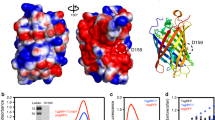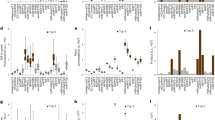Abstract
Femtosecond lasers at fixed wavelengths above 1,000 nm are powerful, stable and inexpensive, making them promising sources for two-photon microscopy. Biosensors optimized for these wavelengths are needed for both next-generation microscopes and affordable turn-key systems. Here we report jYCaMP1, a yellow variant of the calcium indicator jGCaMP7 that outperforms its parent in mice and flies at excitation wavelengths above 1,000 nm and enables improved two-color calcium imaging with red fluorescent protein-based indicators.
This is a preview of subscription content, access via your institution
Access options
Access Nature and 54 other Nature Portfolio journals
Get Nature+, our best-value online-access subscription
$29.99 / 30 days
cancel any time
Subscribe to this journal
Receive 12 print issues and online access
$259.00 per year
only $21.58 per issue
Buy this article
- Purchase on Springer Link
- Instant access to full article PDF
Prices may be subject to local taxes which are calculated during checkout


Similar content being viewed by others
Data availability
Example raw datasets and summary statistics are available through Figshare; https://doi.org/10.25378/janelia.12098361. All other data associated with this study are available from the corresponding author.
Code availability
Custom code is available from the corresponding author, and at https://github.com/KasparP/twoColorUnmixing and github.com/KasparP/SLAP.
References
Grienberger, C. & Konnerth, A. Imaging calcium in neurons. Neuron 73, 862–885 (2012).
Voigt, F. F. et al. Multiphoton in vivo imaging with a femtosecond semiconductor disk laser. Biomed. Opt. Express 8, 3213 (2017).
Kazemipour, A. et al. Kilohertz frame-rate two-photon tomography. Nat. Methods 16, 778–786 (2019).
Wu, J. et al. Kilohertz two-photon fluorescence microscopy imaging of neural activity in vivo. Nat. Methods 17, 287–290 (2020).
Perillo, E. P. et al. Deep in vivo two-photon microscopy with a low cost custom built mode-locked 1060 nm fiber laser. Biomed. Opt. Express 7, 324 (2016).
Kim, D. U. et al. Two-photon microscopy using an Yb(3+)-doped fiber laser with variable pulse widths. Opt. Express 20, 12341 (2012).
Tilma, B. W. et al. Recent advances in ultrafast semiconductor disk lasers. Light Sci. Appl. 4, e310–e310 (2015).
Dana, H. et al. High-performance calcium sensors for imaging activity in neuronal populations and microcompartments. Nat. Methods 16, 649–657 (2019).
Ormö, M. et al. Deletions of the Aequorea victoria green fluorescent protein define the minimal domain required for fluorescence. Science 273, 1392–1395 (1996).
Nagai, T. et al. A variant of yellow fluorescent protein with fast and efficient maturation for cell-biological applications. Nat. Biotechnol. 20, 87–90 (2002).
Wang, Q., Shui, B., Kotlikoff, M. I. & Sondermann, H. Structural basis for calcium sensing by GCaMP2. Structure 16, 1817–1827 (2008).
Behnia, R., Clark, D. A., Carter, A. G., Clandinin, T. R. & Desplan, C. Processing properties of ON and OFF pathways for Drosophila motion detection. Nature 5212, 427–430 (2014).
Strother, J. A. et al. The emergence of directional selectivity in the visual motion pathway of Drosophila. Neuron 94, 168–182.e10 (2017).
Strother, J. A., Nern, A. & Reiser, M. B. Direct observation of ON and OFF pathways in the Drosophila visual system. Curr. Biol. 24, 976–983 (2014).
Valm, A. M. et al. Applying systems-level spectral imaging and analysis to reveal the organelle interactome. Nature 546, 162–167 (2017).
Dana, H. et al. Sensitive red protein calcium indicators for imaging neural activity. Elife 5, e12727 (2016).
Broussard, G. J. et al. In vivo measurement of afferent activity with axon-specific calcium imaging. Nat. Neurosci. 21, 1272–1280 (2018).
Inoue, M. et al. Rational engineering of XCaMPs, a multicolor GECI Suite for in vivo imaging of complex brain circuit dynamics. Cell 177, 1346–1360.e24 (2019).
Sun, Y. et al. Neural signatures of dynamic stimulus selection in Drosophila. Nat. Neurosci. 20, 1104–1113 (2017).
Podgorski, K. & Ranganathan, G. Brain heating induced by near-infrared lasers during multiphoton microscopy. J. Neurophysiol. 116, 1012–1023 (2016).
Studier, F. W. Stable expression clones and auto-induction for protein production in E. coli. Methods Mol. Biol. 1091, 17–32 (2014).
Chen, T.-W. et al. Ultrasensitive fluorescent proteins for imaging neuronal activity. Nature 499, 295–300 (2013).
Akerboom, J. et al. Genetically encoded calcium indicators for multi-color neural activity imaging and combination with optogenetics. Front. Mol. Neurosci. 6, 2 (2013).
Akerboom, J. et al. Optimization of a GCaMP calcium indicator for neural activity imaging. J. Neurosci. 32, 13819–13840 (2012).
Mütze, J. et al. Excitation spectra and brightness optimization of two-photon excited probes. Biophys. J. 102, 934–944 (2012).
Wardill, T. J. et al. A neuron-based screening platform for optimizing genetically-encoded calcium indicators. PLoS ONE 8, e77728 (2013).
Chen, J. L., Voigt, F. F., Javadzadeh, M., Krueppel, R. & Helmchen, F. Long-range population dynamics of anatomically defined neocortical networks. Elife 24, e14679 (2016).
Acknowledgements
We thank H. Davies, C. Morkunas and M. Jeffries for logistical support and S. Di Lisio, K. Ritola, D. Walpita, J. Hasseman and the GENIE Project Team for experimental support. We thank S. Vishwanathan for the gift of Emx1-Cre mice. This work was funded by the Howard Hughes Medical Institute. M.A.M. was supported by the Janelia Graduate Research Fellowship Program. E.J.M., C.-Y.L. and A.A. were supported by the Janelia Undergraduate Scholars Program. Work by J.L.C. and A.M.A. was supported by the National Science Foundation Neuronex Neurotechnology Hub (NEMONIC no. 1707287) and National Institutes of Health BRAIN Initiative Award (no. UF1NS107705).
Author information
Authors and Affiliations
Contributions
K.P. conceived and K.P., E.R.S., J.S.M. and M.A.M. refined the idea. J.S.M. and M.A.M. produced Venus-GCaMPs. E.J.M. performed spectral screening with the help of K.P. C.-Y.L. M.A.M. and A.A. characterized proteins in vitro and M.A.M. and D.S.K. in cultured neurons. A.A. performed individual mutation depletion. Y.L. performed mouse virus injections. K.P., J.J.K. and M.A.M. performed mouse in vivo imaging. A.M.W. and M.A.M. generated fly lines and D.B. designed, performed and analyzed fly experiments. A.M.A. and J.L.C. designed and performed multi-area imaging experiments. R.P. and J.J.M. performed multiphoton spectroscopy and analyzed data. M.A.M., K.P., A.A., J.J.K., D.S.K. and E.R.S. analyzed data. M.A.M., K.P. and E.R.S. prepared the manuscript with input from all authors. K.P., E.R.S. and L.L.L. supervised the work.
Corresponding author
Ethics declarations
Competing interests
The authors declare no competing interests.
Additional information
Peer review information Rita Strack was the primary editor on this article and managed its editorial process and peer review in collaboration with the rest of the editorial team.
Publisher’s note Springer Nature remains neutral with regard to jurisdictional claims in published maps and institutional affiliations.
Supplementary information
Supplementary Information
Supplementary Figs. 1–9 and Table 1.
Rights and permissions
About this article
Cite this article
Mohr, M.A., Bushey, D., Aggarwal, A. et al. jYCaMP: an optimized calcium indicator for two-photon imaging at fiber laser wavelengths. Nat Methods 17, 694–697 (2020). https://doi.org/10.1038/s41592-020-0835-7
Received:
Accepted:
Published:
Issue Date:
DOI: https://doi.org/10.1038/s41592-020-0835-7
This article is cited by
-
Engineering of NEMO as calcium indicators with large dynamics and high sensitivity
Nature Methods (2023)
-
Glutamate indicators with improved activation kinetics and localization for imaging synaptic transmission
Nature Methods (2023)
-
Two-photon calcium imaging of neuronal activity
Nature Reviews Methods Primers (2022)
-
An ultrasensitive biosensor for high-resolution kinase activity imaging in awake mice
Nature Chemical Biology (2021)
-
Flexible simultaneous mesoscale two-photon imaging of neural activity at high speeds
Nature Communications (2021)



